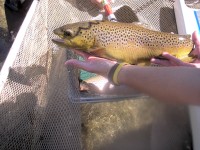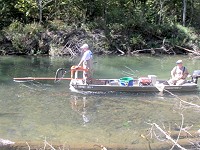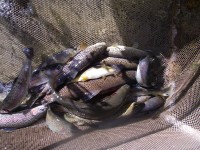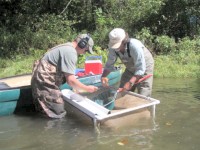Electro-Fishing the Current River
 Many of you have heard me say over and over again that I think that Missouri’s Current River is one of the greatest free-flowing trout streams in the world. How many unregulated rivers are there where you can catch a trophy trout on a dry fly 365 days of the year? Recently, I had the opportunity to help the Missouri Department of Conservation conduct an electro-fishing survey of two section of the Current. The number and size of the fish I saw only confirms my belief in how special the Current is.
Many of you have heard me say over and over again that I think that Missouri’s Current River is one of the greatest free-flowing trout streams in the world. How many unregulated rivers are there where you can catch a trophy trout on a dry fly 365 days of the year? Recently, I had the opportunity to help the Missouri Department of Conservation conduct an electro-fishing survey of two section of the Current. The number and size of the fish I saw only confirms my belief in how special the Current is.
 On Monday morning, September 25th, we started our sampling just below the Montauk State Park and continued down to Baptist. On the 26th, we sampled a two-mile stretch about midway between Baptist and Parker Hollow. On both days we divided into three groups; a shock boat crew, fish holding pen crew and the fish work up crew. The shock boat is a Jon boat equipped with a generator and a converter to supply 200 volts of pulsed direct current to electrodes suspended in the water in front of the boat. The electrical current in the water stuns the fish and allows the netter in the front of the boat to scoop up the stunned trout and transfer them to an aerated bucket in the boat. Once out of the electrical field the trout quickly recovered. After filling the bucket we transferred the fish to a floating holding pen and the shocking continued through the selected reach. We transferred the trout to the floating holding pen as needed. The action could be fast and furious. Typically the netter is only able to collect about 25 to 30 percent of the stunned fish.
On Monday morning, September 25th, we started our sampling just below the Montauk State Park and continued down to Baptist. On the 26th, we sampled a two-mile stretch about midway between Baptist and Parker Hollow. On both days we divided into three groups; a shock boat crew, fish holding pen crew and the fish work up crew. The shock boat is a Jon boat equipped with a generator and a converter to supply 200 volts of pulsed direct current to electrodes suspended in the water in front of the boat. The electrical current in the water stuns the fish and allows the netter in the front of the boat to scoop up the stunned trout and transfer them to an aerated bucket in the boat. Once out of the electrical field the trout quickly recovered. After filling the bucket we transferred the fish to a floating holding pen and the shocking continued through the selected reach. We transferred the trout to the floating holding pen as needed. The action could be fast and furious. Typically the netter is only able to collect about 25 to 30 percent of the stunned fish.
 After the reach was shocked the fish work up crew comes to the floating pen and begins the recording data. They remove each fish individually from the holding pen and the biologist records on an audiotape the species of fish, the presence of any previous fin clips and the length of the fish. Back at the office the data from the tape will be transcribed. Before releasing each fish, the tip of the tail fin was clipped to mark it has having been captured. Clipping the tail fins of all captured fish in the same sections of river on both September 27th and 28th allows the biologist can make a “mark-recapture” estimate of the number of fish in the section. They do this by comparing the number of tail clipped fish collected on each day to the total number fish collected.
After the reach was shocked the fish work up crew comes to the floating pen and begins the recording data. They remove each fish individually from the holding pen and the biologist records on an audiotape the species of fish, the presence of any previous fin clips and the length of the fish. Back at the office the data from the tape will be transcribed. Before releasing each fish, the tip of the tail fin was clipped to mark it has having been captured. Clipping the tail fins of all captured fish in the same sections of river on both September 27th and 28th allows the biologist can make a “mark-recapture” estimate of the number of fish in the section. They do this by comparing the number of tail clipped fish collected on each day to the total number fish collected.
 The biggest fish we collected while I was out with the crew was 24.2 inches long. We did see several fish that size or larger, but we were not able to net them. I was not surprised at any of the locations where we collected good fish. If there was habitat there was a trophy fish. In fact we collected a 19 inch fish from a hole were a client had taken a 19 inch fish on the 22nd. I’m sure it was Joe’s fish. The Current definitely lived up to my billing!
The biggest fish we collected while I was out with the crew was 24.2 inches long. We did see several fish that size or larger, but we were not able to net them. I was not surprised at any of the locations where we collected good fish. If there was habitat there was a trophy fish. In fact we collected a 19 inch fish from a hole were a client had taken a 19 inch fish on the 22nd. I’m sure it was Joe’s fish. The Current definitely lived up to my billing!